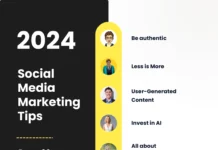All social media marketers know that metrics are important. We proudly present them in end of the month reports and we have a sense of achievement as we see the numbers grow. But not all numbers are equally important: there are vanity metrics vs. actionable metrics.
Many years ago, I was very surprised when I first heard the “vanity metrics” phrase. I was in the middle of reading an article and I just stopped, asking myself what was the real value in some of the numbers that I was so keen on growing. Over the next few days, it kept popping up in my mind at random times, so I started to read more on the subject.

I found many articles about vanity metrics, but most of them were focused on website analytics with some references to social media metrics. We all know there’s value in social media and that insights are crucial for marketers. So which numbers are the most important?
Things are rarely black and white, in reality and in social media. Numbers can mean different things. Some say that the vanity lies in why we choose certain metrics, and not the metrics themselves because metrics are simply the evidence of a result. Which is true, nobody can argue with that.
So just to make sure we’re all on the same page, let’s start by defining the terminology and then we can move on to analyzing which metrics are for vanity and which are actionable.
Vanity metrics are numbers that look good on paper, but you can’t base any business decisions on them. While some of these metrics can indicate the brand health of your business, or show how popular your service is, they have little or no impact on the growth of your product, on sales or conversions. I’m not arguing that these numbers are totally irrelevant. Just don’t be tricked into giving them more importance than you should.
In contrast with them, actionable metrics consist of data that you can use to improve repeatable tasks. These are numbers that you can rely on, when you need to make marketing decisions or when you develop a long-term social media strategy.
This was all just theory. It’s time to get into details and give verdicts: vanity metrics or actionable metrics.
Vanity Metrics vs. Actionable Metrics in Social Media
Followers vs active followers (quantity vs quality)
Audience growth is important for any business. It’s associated with brand recognition and awareness, so you should naturally want the number to be as big as possible. However, in many cases, it really is nothing but a vanity metric. And I’ll explain why.
There are many ways to boost the audience growth if all you want is a bigger number. You can start following a bunch of accounts and you’ll get some of them to follow you back. Then you unfollow those who haven’t followed you back. To make things simpler, there are tools that will automate the process for you, so the audience growth is guaranteed.
But here’s the thing: if you use an automated tool, or if you start following random people, you will end up being followed by a lot of fake profiles. Even if you get some real people to follow you, they will rarely fit your target audience profile, so they will not engage much with you or bring any real value to your business.
Another (foolish) way to quickly boost your audience growth is to pay for likes or follows. With a small investment, you will increase your number of followers, but the majority of them will be fake accounts and bots, not real people. Don’t fool yourself. Buying followers or likes sucks. Here’s the data to prove it.
Other ways to quickly grow your audience are: running a contest or an advertising campaign for likes. These are better ways to get followers, but not ideal. The problem with contests is that they attract likes/follows from people that wouldn’t follow your page under normal circumstances, so they either lose interest as soon as the contest is over or unfollow you.
Ad campaigns have their flaws as well: some advertisers complain about getting fake likes.
If you pursue audience growth by all means, then you’re clearly missing out on what you could achieve with social. These numbers will look good on paper, will sound impressive, but you will know that they are meaningless. What do you really have to gain by getting fake followers, other than bragging rights? That rapid growth will not help your business in any way. Those followers aren’t going to engage with your posts in any way and they will not buy from you.
Here’s a tool that will tell you how much of your Twitter audience consists of real users, if you’re curious to know this about your followers.
The right way to grow your audience is to get your customers and prospects to follow you on social channels. You will have active followers who will engage with your content, read your posts and click on links. These are real people, who will consider buying from you and recommend you. Always try to nurture this audience. Think about what they like and what they’d be interested in reading on your page. Talk to them and talk about them, rather than about yourself. Look at correlations to get a better picture of what makes them tick. Take care of real people versus just taking care of numbers, but also let the numbers tell you what kind of posts are the most popular with this audience and you’ll see it grow. Slow, steady, safe. If you need a tool that can help you manage your posts and conversations with your audience, you should consider a free social media management tool that allows you to visualize and manage everything in one place.
Post reach vs clicks
Reach is the number of unique people who see your content on social channels over a certain period of time.
Clicks refer to the number of clicks on links and clicks on posts to expand a photo or video to fullscreen.
These metrics go hand in hand. The higher the post reach, the higher the clicks, because you can’t have any clicks if your posts haven’t reached anyone. It makes sense. So why do we compare them? Because what really matters is not how many people see your posts, but how many of them care enough to engage with them. The click is the simplest form of engagement.
If you want a higher reach, you can easily boost any post on Facebook and your post will show up on a bunch of people’s feed, which is awesome.
However, you should be after clicks, because reach is not a sign of engagement. Your final purpose should be to get people interested enough to want to read more, or view more. A healthy following will interact with your posts. Go after clicks and engagement, and the reach will naturally grow.
Actions vs engagement rate
When we talk about engagement we refer to actions performed on your page or profile. These metrics show how people interact with your content. These actions can be Likes, Favorites, Mentions, Retweets, Comments, Replies or Shares. As you can see, I didn’t count clicks here, even though they are considered engagement, because a click is not a visible action that appears in people’s feeds.
But don’t just count these numbers, because they don’t really show how engaged your audience is. 90 reactions on a post can be huge or low, depending on the post reach. It is important to properly analyze the data that you track so that you can accurately take the temperature of your social media activity.
So what you should do instead, is to check the engagement rate: the percentage of people that interacted with your post in a visible way. The engagement rate shows clearly whether people are interested in what you have to share.
The formula for calculating the average engagement rate is derived as the total number of actions ( detailed above) for a particular period of time, on a certain social channel, divided to the total reach for the posts considered. Then you should multiply the result by 100 to get your average post engagement rate. For Twitter, you should divide the total number of actions to impressions, then multiply by 100.
I encourage you to calculate these numbers separately for each channel, to get a clear picture of how each channel is performing. You can then compare with previous periods or benchmark against competitors if their statistics are public online.
For those of you who are active on multiple social platforms, you might want to look into a tool that gives you detailed reports for all your channels.
One metric to rule them all: Conversion rate
The ultimately actionable metric is conversion rate. Facebook or Twitter can’t really tell you how much traffic they have driven to your website and they can’t tell you how many of your social followers registered, subscribed, or bought something from you. Luckily, there are other ways.
With Google Analytics you can measure all the website traffic that comes from social channels and you should keep an eye on it. You can even track registration rates and transactions if the code is properly set up to track that on your site. For some people, the most important thing is to get traffic, for others, transactions are more important.
Tracking conversions and traffic will help you optimize your social media strategy in many ways. Compare spikes in visits and registration rates (from social) with post types and topics to see if you notice patterns.
Analyze the channel that is bringing in the most traffic and refine your strategy to bring in even more. You might realize that you’re wasting energy on a poorly converting channel, so you will be able to adjust the strategy.
——–
While there isn’t a clearly defined line between vanity and actionable metrics, a smart marketer will know better than to bloat numbers or present them without context, just for bragging rights. In the end, it’s important to remember that no metric or number has to mean in isolation from the other related metrics.
If you say that your audience growth on Facebook is 150%, you should also present the actual number that you started with, because it’s a very different scenario if you have 1,000 followers or 100,000 followers. Present the whole story and not just a group of well-chosen metrics that sound good.
When you check your social media reports you shouldn’t just look at numbers and percentages. You need to think about real people, real interactions, and how this all fits in with your general marketing strategy.
See also: Top Social Media Mistakes You Must Avoid When Branding Your Business











